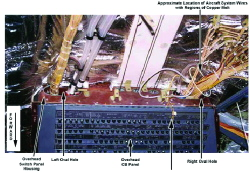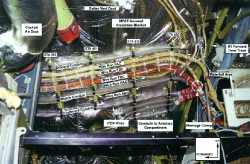Rare occurrence of an inflight fire leads to setting a
higher materials flammability standard
FRANCES FIORINO/NEW YORK
Swissair Flight 111
leaves a valuable safety legacy: Investigators were able to
review aircraft flammability standards and improve testing and
certification of materials. It also leaves a painful legacy:
The lead investigator says there wouldn't have been an
accident if flammable materials hadn't been positioned next to
arcing wires.
 Flight 111 investigators found regions of wire copper
melt in the fire initiation area. The fire likely started
with electrical arcing "involving one or more wires."
Flight 111 investigators found regions of wire copper
melt in the fire initiation area. The fire likely started
with electrical arcing "involving one or more wires."
|
According to the Transportation Safety Board (TSB) of
Canada's final accident report, the inflight fire that led to
the Sept. 2, 1998, crash of the MD-11 had "most likely started
from an electrical arcing event that occurred above the
ceiling on the right side of the cockpit near the cockpit rear
wall" (see photo above).
The arcing of one or more wires in turn ignited the
flammable cover material--metallized polyethylene
terephthalate (MPET)--on nearby thermal acoustic insulation
blankets (see photo, p. 63). A segment of arced electrical
cable from the inflight entertainment network (IFEN) is
believed to be associated with one or more of the arcing
events.
However, the TSB was unable to conclude whether arcing of
an IFEN wire was involved in the initial fire event. Other
flammable materials in the area, including silicone
elastomeric end caps and metallized polyvinyl fluoride
insulation blanket materials, helped to sustain and propagate
the fire.
Deteriorating conditions in the cockpit resulted in the
pilots losing control of the aircraft, which plunged at a
speed of 300 kt. into the waters 5 naut. mi. southwest of
Peggy's Cove, Nova Scotia. All 215 passengers and 14
crewmembers died in the crash.
 The FAA's June
2000 airworthiness directive gave operators five years to
remove flammable MPET materials from MD-11s.
The FAA's June
2000 airworthiness directive gave operators five years to
remove flammable MPET materials from MD-11s.
|
It took the TSB 4.5 years, C$57 million ($38.8 million) and
up to 4,000 people at one stage to complete the investigation.
Recovery, sorting and cataloging of the wreckage took 18
months. Divers, a heavy ship barge and remotely operated
vehicles (ROVs) retrieved about 2 million pieces of wreckage,
or 98% of the aircraft (measured by weight) from 200-ft.-deep
waters.
When recovery was complete, investigators set out to piece
together the events that unfolded during the flight's final
minutes:
Flight 111 departed New York JFK International Airport at
8:18 p.m.local time on Sept. 2, 1998, en route to Geneva.
About 53 min. later, when the MD-11 was at Flight Level 330
(33,000 ft.), the first officer reported an unusual odor in
the cockpit, and there was a small amount of smoke visible on
the flight deck.
Both pilots concentrated on trying to determine its cause,
instead of expediting plans to land immediately, according to
the report. At 9:14 p.m., when the aircraft was about 66 naut.
mi. southwest of Halifax, the crew informed Moncton Control
Center of smoke in the cockpit and issued a "pan, pan, pan"
message. Controllers suggested Halifax International as a
diversion airport instead of Boston.
Meanwhile, failed end caps on air-conditioning ducts fed a
steady supply of air to the fire that raged in an inaccessible
area, while smoke and fumes seeped into the cockpit.
The aircraft was cleared to proceed directly to Halifax and
descend to FL290 from FL328 when it was 56 naut. mi. from
Halifax Runway 06.
The crew, who had donned oxygen masks, was focused on
dealing with a diversion to an unfamiliar airport at night,
and the approach charts to Halifax were not within easy reach,
according to the report. The aircraft's descent rate increased
to 4,000 fpm.
Aircraft checklists did not deal adequately with smoke
conditions, according to the TSB. The report notes that during
the lead arcing event, the associated circuit breakers did not
trip. No fire suppression equipment was near the area, and
there was no integrated inflight firefighting plan in
place--nor was there any regulatory requirement for either.
The accident report points out that the crew was
"essentially powerless to aggressively locate and eliminate
the source of fire or to expedite plans for emergency
landing."
The crew declared an emergency at 9:24 p.m. This was
followed by a series of electrical and navigation equipment
system failures. The cabin crew indicated electrical power was
lost in the cabin, and flashlights were being used to prepare
for emergency landing.
When the primary flight displays failed, the crew had to
adjust to small standby instruments, which added to the
workload (AW&ST Jan. 7, 2002, p. 43). Gradually overcome with
heat and fumes, the pilots lost situational awareness, and the
MD-11 crashed into the sea at 10:31 p.m. The report notes that
although the crew recognized the necessity for a diversion,
they did not believe the threat to the aircraft was sufficient
to declare an emergency or initiate an emergency descent
profile. The report notes that from the time the peculiar odor
was detected, "the time required to complete an approach and
landing to Halifax . . . would have exceeded time available
before the fire-related conditions in the cockpit would have
precluded a safe landing."
ACCORDING TO Investigator-in-Charge Vic Gerden, "One
of the most important aspects of this investigation was our
examination of the flammability standards and the flammability
of various materials. It is rare to have a fire on board a
large commercial aircraft, and we were able to glean a lot of
information about the materials and look to the tests used to
certify those materials. Without the readily flammable
material in this airplane, this accident wouldn't have
happened."
Among the 11 causes and contributing factors, the TSB found
materials flammability as the "most significant deficiency"
uncovered in the most complex aviation safety investigation it
had ever undertaken.
The Flight 111 final report also said the certification
testing procedures, mandated by flammability standards in
effect at the time, were "not sufficiently stringent or
comprehensive to adequately represent the full range of
potential ignition sources." Nor did the procedures mirror the
behavior of materials installed in combination, at various
aircraft locations and in "realistic" operating environments.
"The lack of adequate standards allowed materials to be
approved for use in aircraft, even though they could be
ignited and propagate flame."
The report said two factors shaped those standards. In the
mid-1970s, the FAA concentrated its fire prevention efforts on
improving cabin interior materials and setting higher
standards for materials in designated fire zones--with lower
priority given to fire threats in other areas. The
non-fire-zone hidden areas were viewed as not having potential
ignition sources and flammable materials, two elements
required for a fire, according to the report.
Canada's TSB alone issued 23 safety recommendations, along
with myriad safety advisories and information letters. The
board's latest recommendations, which were issued with the
final report, address the testing and flammability standards
of in-service thermal acoustic insulation materials. They also
call for taking extra measures in the certification of add-on
electrical systems and setting industry standards for circuit
breaker testing. The TSB also has proposed improvements to
capture and store mandatory and non-mandatory flight data, as
well as the installation of cockpit image recording systems.
Previous recommendations included a call for wire
inspections, the removal of MPET from aircraft, and
development of new flammability testing criteria. They also
urged that crews be provided with additional guidance material
to deal with smoke situations, and that checklists be
modified.
A number of safety actions have already been taken. The
FAA's June 2000 Airworthiness Directive ordered operators to
remove MPET from aircraft. The AD, which affects Douglas
heritage aircraft along with the MD-11, gave operators five
years to comply--and this means the flammable materials will
remain installed on in-service aircraft until 2005.
The FAA also conducted a review of problems in the MD-11
service life and developed a plan to correct wiring
deficiencies, which a Boeing official said essentially calls
for a re-rigging of wire systems. The FAA plan includes 61
final-rule ADs and 59 NPRMs (notices of proposed rulemaking).
The agency also started the Enhanced Airworthiness Program for
Airplane Systems for increased awareness of wire system
degradation and improvements in wiring maintenance.
There's still work to do, said Gerden. "Now it's our job to
ensure that follow-ups on safety actions are taken."
See Also:
İApril 14, 2003, The McGraw-Hill Companies
Inc.
